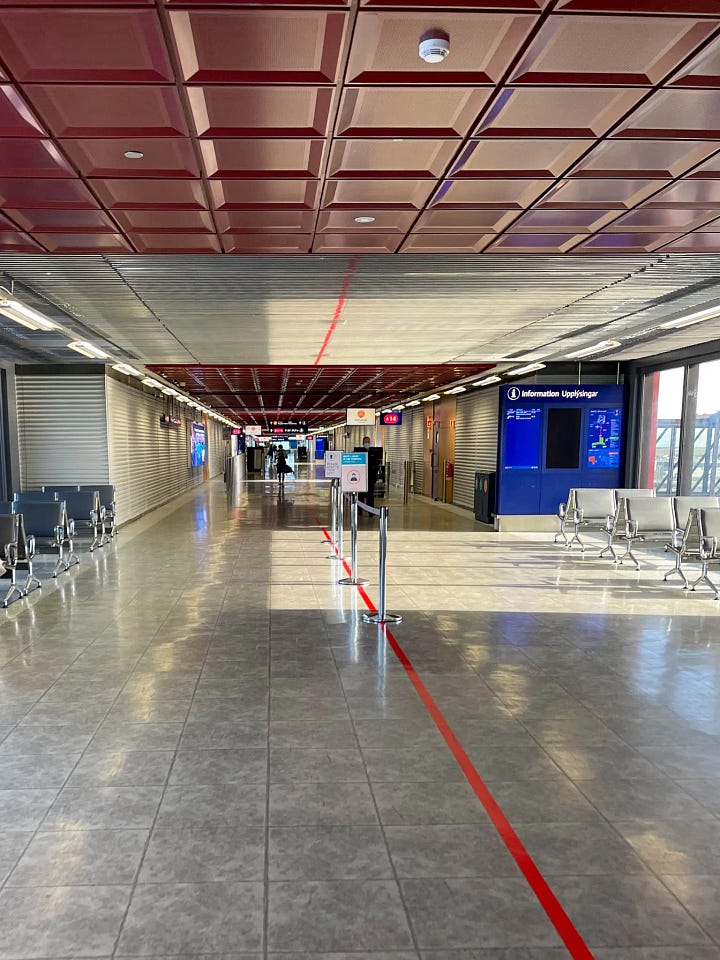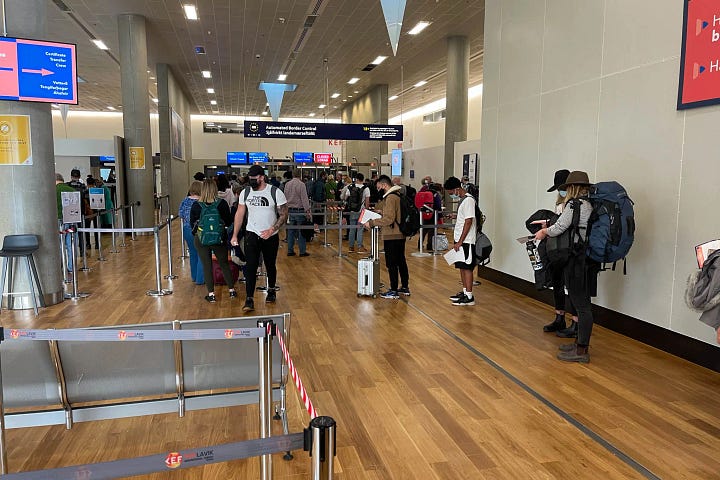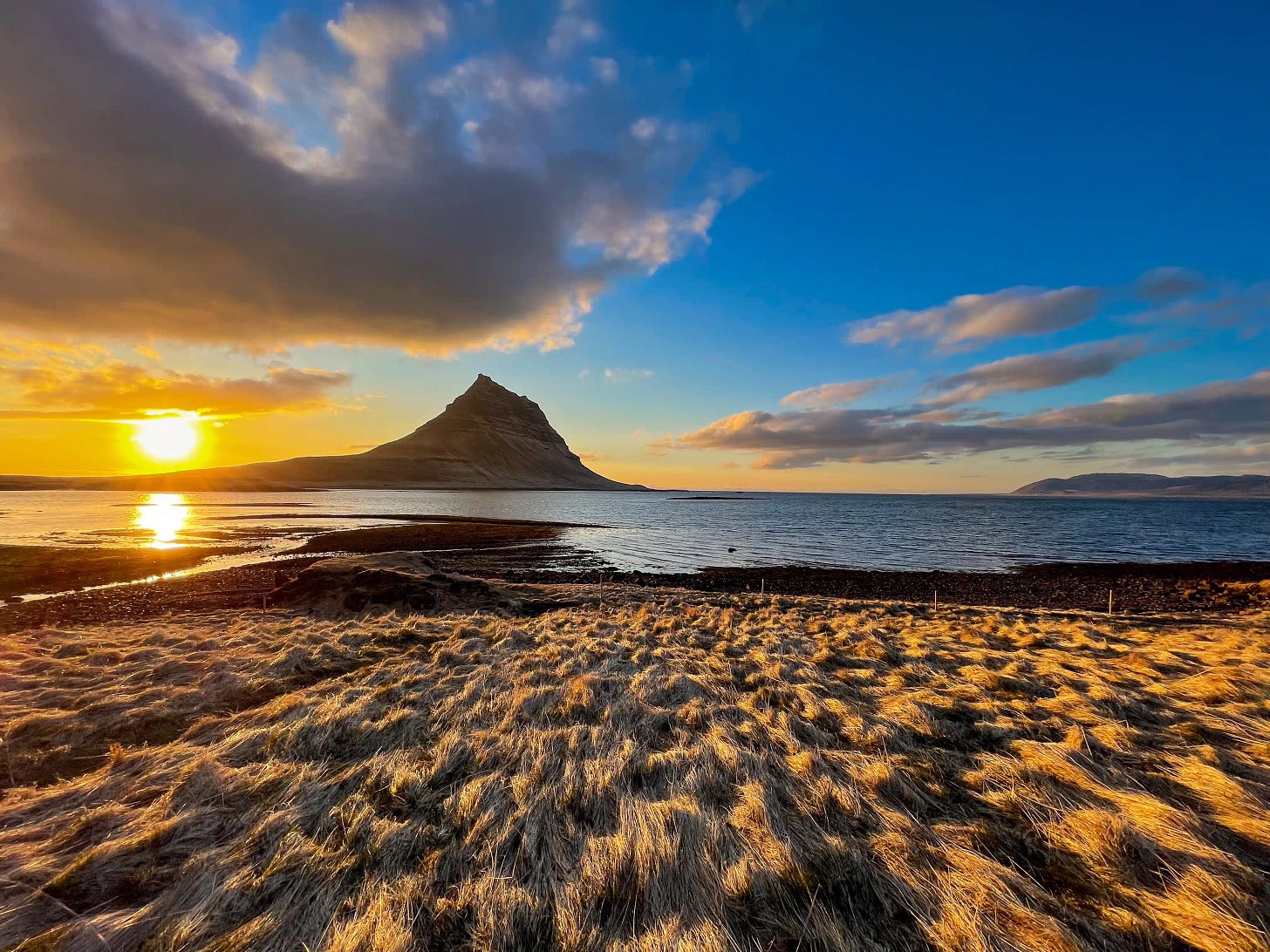Finding Magic in the Westfjords of Iceland
A glass of brennivín and some briny, crackling seared cod cheek.
As the cast iron skillets passed in front of me, I could hear the crackling fish skin and smell the buttery, briny aroma filling the air of the old converted stable. At a small tavern in the remote Westfjords of Iceland, I knew I was in my happy place.
I don’t think I ever booked a flight so quickly. As soon as I had the date of that second COVID-19 vaccine, I was gone, baby. The “where do I go?” decision paralysis was made easy as those with itchy feet could only really go to one place in May of 2021 - Iceland.
Managing to keep COVID-19 at bay (for the most part) and setting up strict protocols, Iceland was the first country to let tourists back in, as long as you were vaccinated and passed a COVID test on arrival. But this was fortuitous; I had always wanted to return to Iceland after my brief stopover a few years ago.
So I packed my bags and headed to Iceland in style, #vanlife style.
Iceland officially re-opened on March 18th, 2021, and I landed on May 7th. Between the few travel-eager/able people vaccinated and the infrequency of international flights, I'd imagine my flight there was at least in the first handful the country had seen since the pandemic started. Honestly, while en route, I didn't think I would even step foot in Iceland. In the back of my mind, there was this lingering feeling and expectation that some bureaucratic or documentation mishap would curtail my trip.
But after a long red-eye journey from Seattle, I arrived at the Keflavík International Airport. The experience can only really be described as surreal. The airport was eerily empty - the coffee shops, restaurants, and shops were all deserted and not operational. Right off the jet bridge, we were funneled through a precise pathway with checkpoints along the way, ensuring appropriate documentation was provided. Tired and a little delirious, I eventually made it to the COVID testing area with nurses too eager to swab the inside of my brain.




I can't quite put my finger on the energy in the airport that morning. Excitement? Anxiety? Optimism? Skepticism? Caution? All felt to varying degrees. Perhaps more than anything, it felt like one big test, with many around the world waiting to see what would happen.
But I passed all the checkpoints and, after a couple of hours of waiting at my quarantine-approved hotel, the COVID test itself. I was free.
So what does one do after an emotional, stressful, and otherwise surreal experience? The only logical answer was the Blue Lagoon. After all, I was about to embark on a 10-day van-life road trip, so why not pamper myself just a bit?
While at the Blue Lagoon, I met two fellow travelers who happened to be on the same flight as me. And as fate would have it, both were from the Pacific Northwest and on a similar post-quarantine van-life trip through Iceland. From that moment on, my journey changed. Rather than a solo trip, it became a caravan around the country.
The first stop on our road trip was that same night. Not too far from the Blue Lagoon was Fagradalsfjall, the volcano which started erupting earlier in the year. The locals had dubbed it a “tourist volcano” since it posed little threat, and you can get pretty damn close.
But at this point, it was around 10 pm. Thinking I would only be indulging myself at the Blue Lagoon, I was ill-equipped to handle the sharp winds and fading (albeit slowly) sunlight, and thus, admittedly skeptical to start a hike. But as I crested a nearby hill in my van, I could see the distant sky being lit by the purple, pink, and orange hues of the erupting lava. I was sold.
The hike went through a few miles of otherworldly volcanic rock, constantly reshaped by the ongoing eruption. After a few miles, the trail starts to gain in elevation. The small, loose gravel made it hard to maintain traction, especially as twilight faded. I could only think about what a bitch this will be going back down later.
After a few precarious steps, I saw the most magnificent thing I’ll ever see. Not more than a half-mile away was Fagradalsfjall.
The volcano was a symphony of mesmerizing power. Every few minutes, you could see a river of lava starting to flow from the volcano’s base. Gradually, the size would build, resulting in a crescendo of lava and thunderous eruption. I wasn’t carrying an evil ring, but I could feel the spectacular power draw me in all the same.
That was my first night in Iceland.
The following day, still captivated by last night’s adventures, my newly acquired travel friends and I headed to the Snaefellsnes Peninsula.
Northwest of Reykjavík, the Snaefellsness Peninsula has almost everything you want in Iceland: beautiful waterfalls, rugged seasides, thermal spas, and quaint towns. Not to mention one of the most iconic landscapes you’ve probably seen:
It was a long day of driving. And that’s one thing people don’t tell you about trips to Iceland; be prepared to spend a lot of time in the car. I’m talking at least 3-5 hours each day.
But with time in the car comes self-reflection. For me, this was mainly filled with time thinking about the past year's difficulties. Challenges that have struck a chord with most people: losing loved ones, isolation, mental and physical distress, and civil unrest, to name a few. For me, it was a loss of identity.
Ever since I stepped foot on the tarmac in Geneva, Switzerland - my first international trip -my subsequent years have been planned around what foreign land I'd explore next. I love being on the road. I love meeting new people. I love the moments that make me realize I’m experiencing life. I love every moment of traveling, even the not-so-fun ones. But perhaps most of all, I love the feeling of being an outsider. Being unknown. Operating in the shadows is where I've always felt most comfortable.
Having that ripped away was probably the most challenging aspect of the past year for me. Admittedly, the pandemic has been much more painful and difficult for others. It's hard not to sound delusional when compared to the immense pain and grief felt by so many over the past year. But in hindsight, the lack of travel had a rather profound effect on me, and honestly, I didn’t even realize it for the longest time. Something was missing; I didn’t know what it was.
In many ways, the first 24 hours of this trip were symbolic. It would be easy to think that humans would turn more inward after a year of turmoil. After a year of isolation, repression, and loss, there wasn’t much reason to talk to strangers. Yet there I was, road-tripping through foreign lands with two people I didn’t know until 24 hours ago.
At one point during my drive, I had a rare flicker of optimism; maybe, just maybe, the shared trauma we endured the past year could help bring us together. Perhaps we'll emerge stronger, more empathetic, and craving human connection. Of course, I have no doubts that one look at CNN would shatter that optimism — fortunately, I was driving.
Anyway, onward and upward.
After a day of exploring, we rolled into town, a small village on the northern end of the Snaefellsness peninsula. Tired and hungry, we were in search of food.
The odd thing about road-tripping and hiking through Iceland is that you tend to lose track of time due to the seemingly endless daylight. Couple that with sleep deprivation and jetlag, what feels like dinner time could end up being 10 pm. This is a mostly fantastic problem - more time for driving and adventuring. The thing is, though, most kitchens are closed at 10 pm.
One place seemed to have some current patrons we could see through the glass window, so we investigated.
While waiting to get seated, this incredibly Icelandic-looking waitress (think blond hair, a strong jaw, and cheekbones that could cut glass) approached us.
“The kitchen is closed. We only have cake and booze,” she said, noticing our eyes wandering toward the food section of the menu.
Of course, we obliged, convincing ourselves that beer has carbs and is, thus, food. Or was that just me?
At the table and happily sipping the local Icelandic beer, Gull, the waitress came back.
“You look like you need a shot,” ostensibly referring to the exhaustion and jet lag written all over our faces. Without giving us a chance to answer, she asked, “Do you want to see the bottle before or after?” The obvious choice was after.
Two menacing shot glasses filled to the brim with clear liquor are set down, taunting us to pick them up.
“Skål!” and down the hatch it goes. It was brennivín - caraway-flavored Icelandic hooch.
She invited us to the bar and gave us samples of various Icelandic brennivín and beer made throughout the country using local flora and fauna like algae, birch, and wild berries.
At this point, it became rather apparent to us that our waitress, too, had imbibed in some of the local fire water. She told us how Icelanders drank brennivín to stay warm in the dark, brutal winters. How there are fairies and magic in the Westfjords. How we should stand up naked and pee into the wind!
That was the second night.
For the next few days, our caravan went up and down the south side of Iceland. We saw more waterfalls than you could count, ate hárkal (fermented shark), walked on glaciers, and shared camp meals.
All I could think about during these few days was that this is what traveling is all about. Not the cool pictures to post on social media or other fodder for our online lives - which some attempt to make a career (sigh). Travel is about our experiences and the human connection we find along the way, like sharing a glass of brennivín with two strangers at the edge of the world.
But everywhere we went, it was empty. Iconic locations you’ve seen posted all over social media with only a handful of other people. Iceland, and the world, clearly still waking from the COVID slumber. Remnants of food trucks and small campsite economies that once were, or according to Google Maps, should still be.
Some Icelanders saw it as a relief, a respite from the constant revolving door of tourism the country has seen over the last few years. But some business owners didn’t share that sentiment. When I talked with Eimverk Distillery, it was clear that a significant portion of their business came from Duty-Free airport stores. No tourists, no money.
But rest assured; the tourists will be back. They’ll be back in droves. As I write this, a mere two months after my trip, Iceland has already seen an influx of tourists and travelers from all over as vaccines become more widely available. Or at least social media tells me so.
But for those few days, we experienced a truly unique Iceland that might not be seen again for a long time. And for that, I’m thankful.
Eventually, though, my companions and I had to part ways. It was time for me to head west.
Back in the Westfjords, I had left my impromptu friends of the past week.
Initially, I had intended to make the Westfjords the bulk of my itinerary; the prospect of vast emptiness was alluring. The Westfjords, I was told, are more like “old Iceland” - remote, rugged, and magical. That’s all I needed to hear.
On a map, the Westfjords might not look all that extraordinary - a few tendrils poking out on the northwest section of the island. However, the only way to navigate them is to drive into and out of these massive snow-capped fjords crashing into the sea. It takes hours (even two days) to drive around the Westfjords. But within the first few minutes, you feel their gravity.
A long day of beautiful yet grueling driving left me tired and peckish, so I desperately needed some libations.
Being at damn near the top of the world, there weren’t many options to choose from in their “largest” town, Ísafjörður


. Fortunately, I stumbled on Tjöruhúsið, a local seafood spot in town.
The place is set in an old converted farmhouse nestled between two massive fjords. Inside are a handful of wood benches; seating is communal style. A flat 7,000 ISK (roughly $55) will get you as much seafood as you want, and you can eat; a buffet, if you will (drinks not included).


The first course is a langoustine and cod seafood stew in a creamy tomato base. Like a novice, I gorged myself on too much seafood stew; but damn, was it good. After that, the kitchen brought out an array of cast iron skillets filled with sizzling goodness. Different kinds of fish such as cod, plaice, and trout are prepared every which way. All caught the same morning, of course.
The waiter - a big, burly Icelandic man - scurried around the farmhouse, tending to me and two other patrons. He made it to my table, cast-iron skillet in hand, and placed a piece of Cod tongue on my plate. It was fucking good. Delicate, crispy, and full of flavor.
After perhaps the most incredible seafood meal of my life, the waiter and owner of the restaurant sat down with me. For a couple of hours, we shared some beer and brennivín, talking about Iceland, COVID, his restaurant, and just about any topic that is likely discussed over drinks.
Before I left, I asked him if it was true that Icelanders used to drink brennivín to stay warm during the cold winter nights.
"Nah, we just like getting drunk," he replied.
Back at camp, I settled in for the night. But the lingering Westfjord twilight meant light wouldn’t fade for another few hours, at least. So I poured myself a glass of brennivín and stepped outside.
And suddenly, I felt it; that sense of identity was back, if only for a moment.
I took a breath. I took a sip.








